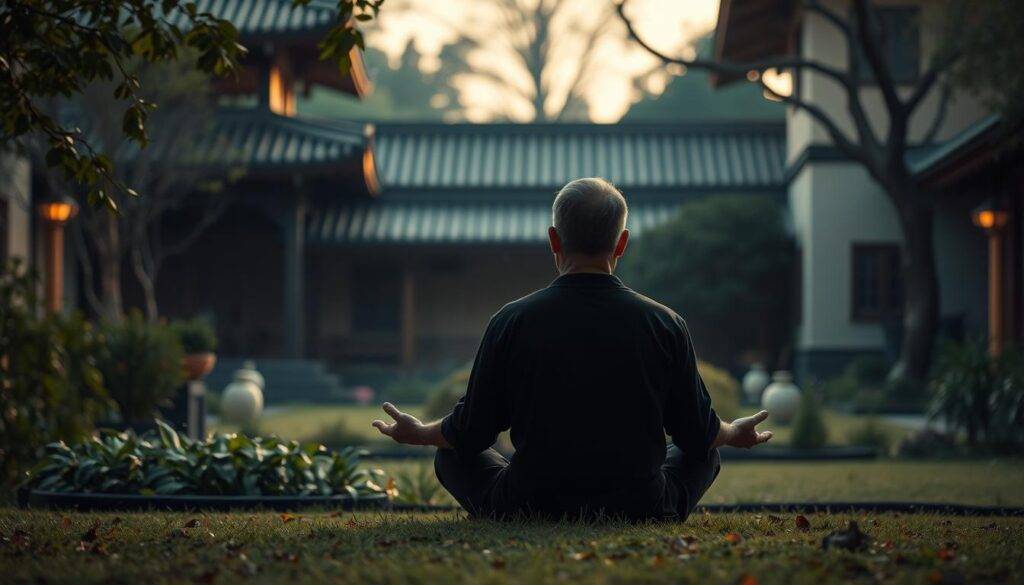“The only real valuable thing is intuition,” Albert Einstein once remarked. In a world that prioritizes schedules and spreadsheets, his words remind us that true clarity often emerges when we listen to quieter, deeper signals.
Modern life demands structure—yet something primal calls us to trust our instincts. How do we honor both? The answer lies in aligning inner wisdom with purposeful action. Your body, gut, and emotions constantly send signals—like a compass pointing toward choices that resonate with your authentic self.
Consider this: logic thrives on data, but intuition thrives on awareness. Practices like body scan meditation help decode physical sensations linked to decisions. Journaling unveils patterns in your thoughts and feelings. These tools don’t reject structure—they refine it.
This article explores how to blend instinct with intention. You’ll discover mindfulness techniques to quiet mental noise, cultural perspectives on trusting your gut, and exercises to strengthen self-trust. The goal? To create a life that feels both focused and free.
Key Takeaways
- Intuition acts as an internal compass, guiding decisions beyond pure logic.
- Balancing structure with self-trust enhances personal and professional growth.
- Body awareness practices help identify physical cues linked to your truth.
- Journaling reveals hidden patterns in thoughts and emotional responses.
- Cultural research shows intuition’s role in successful decision-making.
Setting the Stage for Intuitive Living
While calendars govern our days, cultures worldwide have long valued the body’s silent language. This tension between external demands and internal guidance defines modern decision-making. To navigate it, we must first decode what intuition truly means today—not mystical guesswork, but a blend of sensory input and subconscious pattern recognition.
Understanding Intuition in Modern Life
Neuroscience reveals that gut feelings originate from the enteric nervous system—a “second brain” communicating with your head. Indigenous traditions frame this as listening to land and body, while Eastern practices like Qi Gong teach energy alignment. Western psychology, however, often dismisses hunches unless validated by data.

The Intersection of Freedom and Structure
Structured routines create space for spontaneity. Consider Japanese ma—the intentional use of empty time—or Silicon Valley’s “20% time” policies allowing creative exploration. Both systems prove that boundaries can amplify, not restrict, self-trust. As one Lakota elder notes: “Dance follows the drum’s beat, but your feet choose their steps.”
Your body offers real-time feedback: a clenched jaw during meetings, lightness after certain choices. Recognizing these signals builds the foundation for integrating intuition into daily life—without abandoning practical frameworks.
Intuitive Living Strategies: Embracing Your Inner Voice
Every decision carries a whisper of truth waiting to be heard beneath the noise. Strengthening this connection requires deliberate practices that bridge instinct and intention. Start by carving out moments of stillness—even five minutes daily—to create space for self-reflection.

Developing Inner Wisdom
Daily journaling acts as a mirror for your subconscious. Write three quick responses to: “What choice today felt aligned?”, “Where did hesitation arise?”, and “What physical sensations accompanied these moments?” Over time, patterns emerge, revealing how your inner wisdom communicates through emotions and bodily cues.
Body scan meditation sharpens this awareness. Lie comfortably and mentally trace sensations from toes to scalp. Note areas of tension or ease—these often correlate with unresolved decisions or affirming truths.
Practical Exercises for Tuning In
Combine these methods into a weekly routine. For example, pair morning journaling with evening breathwork. Track progress using a simple table:
| Practice | Focus Area | Key Benefit |
|---|---|---|
| Guided Body Scans | Physical Awareness | Identifies stress triggers |
| Prompt-Based Journaling | Emotional Patterns | Clarifies gut reactions |
| Breath Counting | Mental Clarity | Reduces decision fatigue |
Trust builds gradually. Missed cues aren’t failures—they’re feedback. As one executive coach observes: “The body never lies. It just waits for you to listen.”
Cultivating Awareness: Mindfulness, Meditation, and Body Dynamics
True awareness begins when we pause to decode the language of our physical and mental states. Tight shoulders might signal unresolved stress, while shallow breathing often accompanies uncertainty. These bodily cues form a silent dialogue with your inner wisdom—one that grows clearer through mindfulness practices.

Body Scan Techniques
Start by lying comfortably and mentally scanning from toes to scalp. Notice areas of warmth, tingling, or stiffness. A clenched jaw could reveal hidden tension about a decision, while relaxed hands might confirm alignment with a choice. Practice this daily to sharpen your ability to reconnect with your inner guidance.
| Technique | Duration | Primary Benefit |
|---|---|---|
| Progressive Muscle Relaxation | 10 minutes | Releases physical stress |
| Visualized Energy Flow | 8 minutes | Enhances mind-body connection |
| Grounding Foot Focus | 5 minutes | Stabilizes emotional responses |
Deep Breathing and Meditation Practices
Four-count breathing—inhale for 4, hold for 4, exhale for 6—calms the nervous system within minutes. Pair this with morning meditation to create mental space for clearer decision-making. Over time, these habits train your mind to distinguish fear from genuine intuition.
Evening reflection amplifies results. Ask: “Where did my body guide me today?” Record one physical sensation that influenced a choice. This builds trust in your body’s innate wisdom while maintaining productive routines.
Trusting Your Gut: Practical Ways to Listen Deeper
Decisions often sit at the crossroads of logic and feeling—a space where gut instincts reveal hidden truths. Trusting these signals strengthens decision-making by merging subconscious knowledge with conscious action. The key? Developing habits that honor your body’s wisdom while maintaining clarity.

Journaling to Capture Gut Instincts
Free writing unlocks raw intuition. Set a timer for three minutes and jot down unfiltered thoughts about a decision. No editing, no pauses—just flow. This practice bypasses overthinking, surfacing initial reactions buried beneath doubt. One study found that participants who journaled daily made 23% faster decisions with higher satisfaction rates.
Aligning Vision with Heartfelt Desires
Vision boards bridge goals and emotions. Collect images resonating with your core values—not societal expectations. Place this board where you’ll see it daily. Over time, these visuals rewire the brain to recognize opportunities aligned with your true self. As one life coach notes: “Your heart knows the destination; your gut lights the path.”
| Tool | Frequency | Outcome |
|---|---|---|
| Morning Free Write | Daily | Captures fresh instincts |
| Emotion Check-Ins | 3x/day | Identifies stress patterns |
| Weekly Vision Review | Weekly | Reinforces alignment |
Deeper listening transforms relationships. Notice how your body reacts during conversations—a relaxed posture might signal trust, while crossed arms could hint at unresolved tension. These cues guide more authentic interactions, reducing misunderstandings.
Cultural Reflections on Intuition and Structured Decision-Making
Cultures shape how we weigh instinct against analysis—a dance between ancestral wisdom and modern metrics. From Japanese tea ceremonies timed to heartbeats to Wall Street’s algorithmic trading, societies reveal unique approaches to balancing inner wisdom with external systems.

Eastern and Indigenous Perspectives
Taoist philosophy views intuition as wu wei—effortless action aligned with nature’s flow. Zen masters teach students to “drink tea when thirsty,” emphasizing instinct over overthinking. Similarly, Māori elders use whakapapa (genealogical connections) to guide community choices, trusting centuries of ancestral knowledge.
One Lakota leader explains: “We don’t decide for the tribe. We listen until the land whispers the answer.” These traditions treat intuition as collective intelligence refined through generations.
Western Approaches to Evidence and Logic
Modern business culture often demands spreadsheets before trust. Steve Jobs famously said design choices should “feel right before the data proves it,” yet most CEOs face pressure to justify decisions with metrics. Elon Musk’s “first principles” thinking blends physics-based logic with bold visionary leaps—a hybrid approach gaining traction.
MBA programs now teach “data-informed intuition,” recognizing that 72% of executives credit gut feelings for major successes. However, Western systems still prioritize measurable outcomes, creating tension between heart-led choices and boardroom expectations.
| Cultural Lens | Decision Driver | Outcome Focus |
|---|---|---|
| Indigenous | Ancestral patterns | Community harmony |
| Eastern | Natural rhythms | Personal alignment |
| Western | Empirical validation | Scalable results |
Integrating Intuition into Daily Routines
Daily habits become gateways to deeper self-trust when infused with mindful intention. By anchoring intuitive practices to existing routines, you create frictionless opportunities to honor your inner voice without overhauling your schedule.

Ritual Stacking and Timely Practices
Attach intuitive check-ins to habitual actions. While brewing morning coffee, ask: “What energy do I want to carry today?” Post-work walks become reflection periods—notice one physical sensation signaling alignment or resistance. These micro-moments build awareness without demanding extra time.
Daily Mini-Exercises for Inner Connectivity
Three simple methods strengthen instinctual muscle:
- Palm Check: Pause before meals. Place hands palms-up—if tension lingers, explore its source
- Breath Anchors: Set phone reminders to take four conscious breaths at set intervals
- Evening Debrief: Review three decisions using the “Body/Mind/Heart” framework
| Exercise | Time | Focus |
|---|---|---|
| Palm Check | 30 seconds | Physical awareness |
| Breath Anchors | 1 minute | Mental reset |
| Evening Debrief | 3 minutes | Emotional patterns |
As habit expert James Clear observes: “Small choices repeated consistently create identity shifts.” Over weeks, these practices rewire neural pathways, making instinctual choices feel increasingly natural.
Celebrating Creative Freedom and Focus
Creativity thrives where structure and spontaneity intersect—a space where brushstrokes meet spreadsheets. When you channel imaginative energy into daily choices, you unlock a powerful feedback loop between emotional wisdom and practical results. This synergy transforms routine tasks into opportunities for self-expression and growth.

Harnessing Creativity as a Path to Intuition
Improvisational art—like free-form painting or stream-of-consciousness writing—bypasses overthinking. A study of 200 professionals found those engaging in unstructured creative activities made 37% faster decisions aligned with their values. As one creativity coach notes: “Art isn’t about making pretty things—it’s about making truthful choices.”
Balancing Emotional Wisdom with Logical Decisions
Use the “Heart-Head Check” method when facing tough calls. First, list emotional responses to an option. Then, outline factual pros and cons. Compare both lists to find overlapping insights. This approach honors feelings while grounding them in reality.
| Activity | Purpose | Outcome |
|---|---|---|
| Improvisational Art | Unfiltered self-expression | Sharpens instinctual responses |
| Analytical Brainstorming | Data-driven ideation | Identifies feasible solutions |
| Trust-Building Exercises | Shared creative projects | Deepens relational bonds |
Nurturing Relationships Through Inner Trust
Collaborative creativity builds authentic connections. Try co-writing a story with a partner or designing a vision board with colleagues. Notice how shared creative acts foster empathy and reveal unspoken core values. These moments become touchstones for mutual understanding.
Remember: every choice shaped by creativity strengthens your ability to harmonize heart-led impulses with real-world impact. As poet Maya Angelou once reflected: “You can’t use up creativity. The more you use, the more you have.”
Conclusion
True empowerment emerges when instinct and intention dance in rhythm. Balancing structure with self-trust isn’t about abandoning plans—it’s about refining them through inner wisdom. The practices explored here—from journaling to body scans—help decode your body’s subtle cues, turning everyday choices into opportunities for growth.
Cultural insights remind us that intuition thrives in diverse forms. Whether through Taoist flow or modern data-informed decisions, the core truth remains: your gut knows what aligns with your deepest values. Start small—try a five-minute daily check-in or breath-focused pauses between tasks.
Progress builds through experimentation. Notice how meditation sharpens clarity or how vision boards reveal hidden desires. Each step strengthens trust in your unique compass—blending logic’s maps with your heart’s coordinates.
Now is the moment to act. Celebrate the tension between focus and freedom, knowing both guide you forward. Your journey begins with one question: “What feels true today?” Listen closely—the answer might surprise you.
FAQ
How do I start trusting my gut when making decisions?
Begin by pausing before decisions to notice physical sensations—like tension or ease—and track patterns through journaling. Small choices, like meal selections, build confidence in recognizing bodily signals before applying intuition to bigger life choices.
Can structured routines coexist with intuitive living?
Yes. Rituals like morning meditation or evening reflection create stability, freeing mental space to notice subtle instincts. Tools like time-blocking for focused work allow spontaneous intuition to guide creative gaps in schedules.
What if my intuition conflicts with logic?
Treat both as allies. For example, use pros/cons lists (logic) alongside a body scan to assess how each option feels. Apps like Headspace offer guided exercises to bridge analytical and instinctual thinking.
How can I quiet external opinions to hear my inner voice?
Limit input overload—set boundaries on social media or advice-seeking. Practices like free-writing or walks in nature help drown out noise. Brené Brown’s “arena” metaphor reminds us that only you hold your truth.
Are there quick practices for busy days?
Try the 60-second “STOP” method: Stop, Take 3 breaths, Observe bodily sensations, Proceed. Or use calendar alerts for midday check-ins: “Does this task align with my deeper goals?”
How do cultural views affect intuitive trust?
Eastern traditions like Ayurveda frame intuition as body wisdom, while Western models prioritize data. Blend both: Use apps like Calm for mindfulness and Trello for planning, honoring your unique balance.
Can intuition improve relationships?
Absolutely. Noticing gut feelings during conversations—like unease or resonance—helps set authentic boundaries. Practices like active listening to others and your internal responses foster deeper connections.
What’s a simple way to test if it’s fear or intuition?
Fear often feels urgent and shrinking, while intuition is calm and expansive. Ask: “Does this choice empower or restrict me?” Tools like the Emotion Wheel clarify underlying feelings behind impulses.




























































